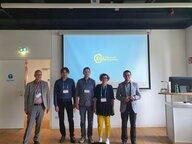
Die Organisatoren der Session "Towards a safe nuclear waste repository". Von links nach rechts: Prof. Klaus-Jürgen Röhlig (TU Clausthal), Dr. Jobst Maßmann (BGR), Dr. Axel Liebscher (BGE), Dr. Václava Havlová (ÚJV Řež), Prof. Thomas Nagel (TU Bergakademie Freiberg).
Zum fünften Mal fand die EGU-Session "Towards a safe nuclear waste repository – assessment of barrier integrity, geoscientific, technological, societal and regulatory challenges and approaches" statt.
Vom 23. bis zum 27.05.2022 fand die General Assembly of the European Geophysical Union in Wien statt. Zum fünften Mal in Folge haben wir eine Session zum Thema Atommüllentsorgung (Beschreibung siehe unten). Wir möchten uns bei allen Autoren für ihre Beiträge zu einem so breiten Themenspektrum und bei allen Teilnehmern für die Teilnahme an der Diskussion bedanken. Wir freuen uns auf ein Wiedersehen im nächsten Jahr.
Towards a safe nuclear waste repository – assessment of barrier integrity, geoscientific, technological, societal and regulatory challenges and approaches
The successful implementation of safe deep geological disposal of spent fuel, high-level waste and other long-lived radioactive waste is one of the currently most pressing environmental challenges in several countries worldwide. Site investigation and selection are primarily geoscientific tasks that require interdisciplinary collaboration of different disciplines, like geophysics, hydrogeology, (hydro-)geochemistry, mineralogy, geomechanics, material science, and geological as well as THMC modelling. Moreover, successful and socially accepted site selection and disposal implementation depend not only on geoscientific state-of-the-art results, sound engineering and R&D programs but to a large extent on well-designed public outreach and public involvement/participation activities as well as on suitable regulatory frameworks. As for other subsurface technologies such as the storage of thermal energy and other energy carriers, or the deposition of chemotoxic waste or carbon dioxide, barrier integrity is a crucial aspect for the assessment of nuclear waste disposal. Numerical simulations, in conjunction with experimental studies are an integral part of safety and environmental-impact assessment concepts involving barrier integrity as a key component. Reliable comparative analyses of potential technological options require coupled THMC models capturing the particularities of each rock type and associated repository concept to a comparable level of sophistication. Structural as well as process complexity are often met by data scarcity and variability, necessitating the treatment of uncertainties and variability.Aside from geoscientific and technological aspects this interdisciplinary session also addresses social and regulatory challenges by welcoming contributions from research and technical support organizations, waste management organizations, regulatory bodies, and NGOs. The session provides a platform for the exchange of i) geoscientific, geochemical, geotechnical and material science knowledge for assessing the integrity of multi-barrier systems considering equally conceptual, theoretical, computational and experimental aspects as well as ii) safety assessment strategies and tools, disposal concepts, national and transnational public outreach and involvement programs, siting approaches and relevant regulatory frameworks. Presentations related to other subsurface technologies that face comparable challenges are also welcome.
https://meetingorganizer.copernicus.org/EGU22/session/43545#Presentations
Fragen beantwortet / Contact: Prof. Dr. Thomas Nagel